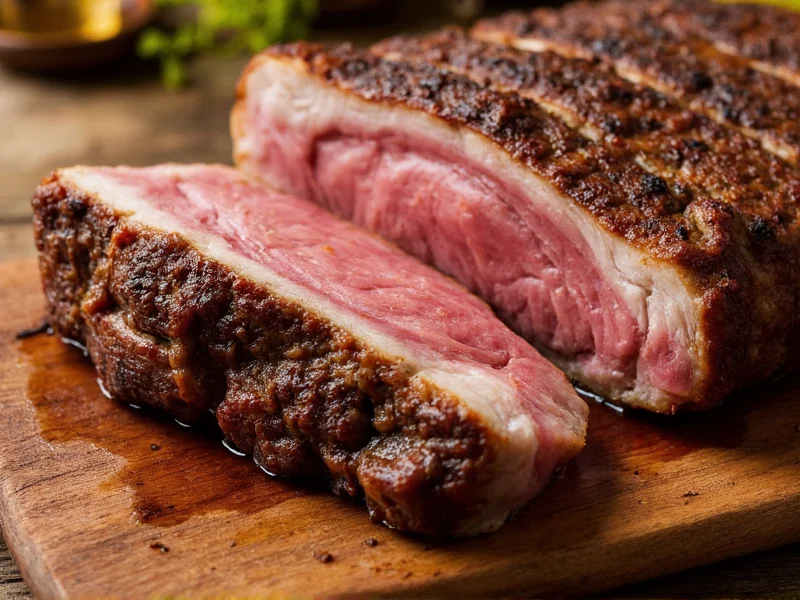When shoppers encounter the term “short ribs” at a butcher counter or grocery store, confusion often arises about their animal origin. This straightforward question “are short ribs beef or pork” deserves a clear, factual answer backed by culinary knowledge and meat science.
Understanding the Source of Short Ribs
Short ribs specifically refer to a cut of beef taken from the plate section (lower rib cage area) or brisket area of cattle. Butchers remove these ribs by cutting between the bones of the rib primal, creating shorter sections—hence the name “short” ribs.
The confusion between beef and pork ribs stems from both animals having rib cuts, but they differ significantly in terminology and characteristics. Pork ribs come from pigs and include varieties like baby back ribs, spare ribs, and St. Louis-style ribs—none of which are ever labeled as “short ribs.”
Beef Short Ribs vs. Pork Ribs: Key Differences
| Characteristic | Beef Short Ribs | Pork Ribs |
|---|---|---|
| Animal Source | Cattle (beef) | Pigs (pork) |
| Location on Animal | Plate section (6th-10th ribs) or brisket area | Back (baby backs) or belly (spare ribs) |
| Bone Structure | Larger, denser bones with substantial meat coverage | Smaller, more delicate bones with less meat |
| Flavor Profile | Richer, beefier flavor with higher fat content | Milder flavor, less intense meatiness |
| Typical Cooking Method | Slow braising or smoking (3-6 hours) | Grilling, smoking, or baking (2-4 hours) |
Why the Confusion Exists
Several factors contribute to the “are short ribs beef or pork” confusion:
- Naming conventions: Both beef and pork have rib cuts, but only beef uses the “short ribs” designation
- Butcher terminology: Some retailers might mislabel cuts, especially in regions where pork is more commonly consumed
- Culinary adaptations: Restaurants sometimes create pork dishes inspired by beef short rib preparations
- International variations: In some countries, similar cuts from different animals might share comparable preparation methods
Identifying Authentic Beef Short Ribs
When selecting short ribs, look for these identifying characteristics that confirm they're beef rather than pork:
- Size and weight: Beef short ribs typically weigh 1-2 pounds per piece with substantial meat coverage
- Bone structure: They feature large, dense rib bones (usually 3-4 inches long)
- Marbling: Visible fat streaks throughout the meat, characteristic of well-marbled beef
- Color: Deep red meat color rather than the lighter pink of pork
- Labeling: Properly labeled packages will specify “beef short ribs” or “plate short ribs”
Culinary Applications of Beef Short Ribs
Chefs prize beef short ribs for their rich flavor and tender texture when prepared correctly. Unlike pork ribs that often work well with quicker cooking methods, authentic beef short ribs require specific techniques:
Braising represents the most traditional preparation method. Chefs sear the ribs to develop flavor, then simmer them slowly in liquid (typically 3-6 hours) until the connective tissue breaks down into gelatin, creating that signature fall-off-the-bone tenderness. This technique works because short ribs contain substantial collagen that needs extended cooking to transform.
Smoking has gained popularity for beef short ribs, particularly the “texas-style” preparation where butchers cut the ribs into individual bones before smoking. This method requires careful temperature control (usually 225°-250°F) for 8-12 hours to achieve optimal results.
Alternative cuts exist for those seeking similar flavor profiles with different preparation times. Chuck roast or blade roast can substitute in some recipes, though they lack the distinctive bone-in presentation of true short ribs.
Selecting Quality Short Ribs
When purchasing short ribs, consider these factors to ensure you're getting quality beef:
- Marbling: Look for even fat distribution throughout the meat
- Meat-to-bone ratio: Higher quality cuts have substantial meat coverage around the bone
- Color: Fresh short ribs display bright cherry-red color (avoid grayish or brownish hues)
- Fat quality: Fat should appear creamy white, not yellowed
- Cut style: Ask your butcher about the cutting method (English cut, flanken cut, or Korean cut)
Common Short Rib Preparation Mistakes
Many home cooks encounter issues with short ribs due to misunderstandings about this cut:
- Insufficient cooking time: Short ribs need extended cooking to break down connective tissue
- High-heat grilling: Direct high heat causes shrinkage without tenderizing the meat
- Ignoring the membrane: Leaving the silver skin intact prevents proper tenderizing
- Over-trimming fat: Excessive fat removal sacrifices flavor and moisture
- Using improper liquid: The braising liquid should complement, not overwhelm, the beef flavor
Why Short Ribs Command Premium Pricing
Despite being a tougher cut, quality short ribs often carry higher price tags than other beef sections. This premium reflects several factors:
- Labor-intensive butchering process required to properly prepare the cut
- High demand from restaurants for premium menu items
- Superior flavor profile compared to other braising cuts
- Increasing popularity in home cooking despite longer preparation times
- Limited availability (only certain sections of the cow yield quality short ribs)











 浙公网安备
33010002000092号
浙公网安备
33010002000092号 浙B2-20120091-4
浙B2-20120091-4